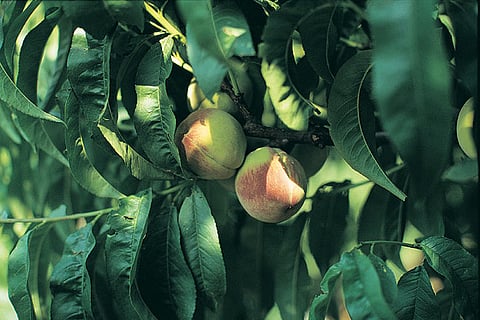

Dull brown is the colour of June. Dry grasses, muddy hills, the Giri&rsquos bed and, as we near Rajgarh, pine cones and dry needles. Then, wet July sets in. The pine forests get thicker, greener. Rajgarh&rsquos market is bustling in mid-afternoon. It&rsquos possible to stand in the sun.
It&rsquos quite cool, but not cool enough, we are told. The changing climate has made history of Rajgarh&rsquos famous peach orchards. We must drive on, higher, towards Fagu. We stretch a halfhour drive by stopping to shoot photographs once too often. Pine gives way to deodar, and a cool darkness descends upon the road. Crickets, birds and the howling wind make the only sounds in this semi-wilderness. One by one, small signboards appear&mdash&lsquosuch-and-such farm&rsquo, but to us they seem orchards. Green, meticulously spaced bushes line the hillside. Some sit on broad terraces, others cling to the slope.
A shack, a signboard and a smiling old man are Fagu&rsquos only representatives on the road. There&rsquos no sign of the village, as such. Keep going, the man tells us. A couple of bends later, we come across the kutcha road leading up to Bhanat village.
This road will be metalled some day, but even now it is good enough for a Maruti. And two of them can pass without getting into a scrape. After about a kilometre of raising dust, we reach another shack stocked with empty wooden crates.
Vibha Orchards, says a board. A peach-yellow house with a green tin roof rises behind the trees. Leaving the car on the road, we make for the house and are announced by sharp barks from Jimmy, the Tomars&rsquo two-year-old Pomeranian.
Vinod Tomar&rsquos orchard is rated the valley&rsquos best. No wonder, we find him negotiating with an agent from faraway Ludhiana. And this is only the start of the plucking season. When the rains set in and the best fruit ripens, he will have his hands full.
A small fan is whirring atop a rack in a corner of the room. Tomar and his cheerful wife find it necessary in the &ldquoJune heat&rdquo that we plainsdwellers are unable to perceive. Nights, they admit, are still very cold. &ldquoWe packed away our quilts only last week but blankets are needed round the year,&rdquo they say. It may be music to tourists&rsquo ears but Tomar is far from happy with the weather.
&ldquoThis summer&rsquos been too dry the fruit is taking too long to ripen,&rdquo he says. He&rsquos more worried about the overall change in climate. &ldquoIt used to snow heavily earlier. We had good apple and plum yields back then. Now, it&rsquos too warm for those fruits. We are left with peach, apricot, walnut and some almond trees. If it gets any warmer, we&rsquoll have to get rid of peach as well,&rdquo he says.
But for now, Sirmour&rsquos &lsquopeach bowl&rsquo is well and thriving. Tomar leads us into a part of his sprawling estate where the fruit is ready to pluck. Bunches of blushing peaches peek out from behind green leaves.
We sample one each. They&rsquore sweet, albeit a bit firm. &ldquoThey taste best when kept a few days after plucking,&rdquo says Tomar.
The peach season spans June and July. The early variety that we sample is inferior to the late-ripening one. But it fetches a good price due to limited supply. Somewhat like alphonsos in Mumbai, during March. However, with the onset of the monsoon in July, peaches ripen by the truckload and for a couple of weeks this quiet nook echoes with the sounds of straining engines.
Looking around, it&rsquos clear that there are many weeks&rsquo supply left on the trees. Green, downy bunches sway promisingly in the breeze. The Tomars walk us to theircattle shed, built in the traditional manner with living quarters for servants above.

Down in the valley, there are tomato fields and high up on the facing hill, a stone and wood temple modelled on the Bhimakali Temple in Sarahan. It is dedicated to Shirgul, the lord of Choordhar, the highest mountain in Sirmour. Tomar says that Fagu, in fact, can be a base camp for trekkers headed for Choordhar. &ldquoBut it&rsquos a rather long trek from here and will take a day,&rdquo he adds.
It&rsquos late evening when we leave the orchard and set out for Shaya village to see the Shirgul temple. After driving past deodars and orchards for 5km, we turn up another dirt track leading to the temple.

Ten minutes later, we step inside a doorway with hundreds of coins nailed on its sides. They are offerings for prayers answered, explains the priest. We make a little prayer of our own before slipping out of Sirmour&rsquos peach bowl in the fading light.
